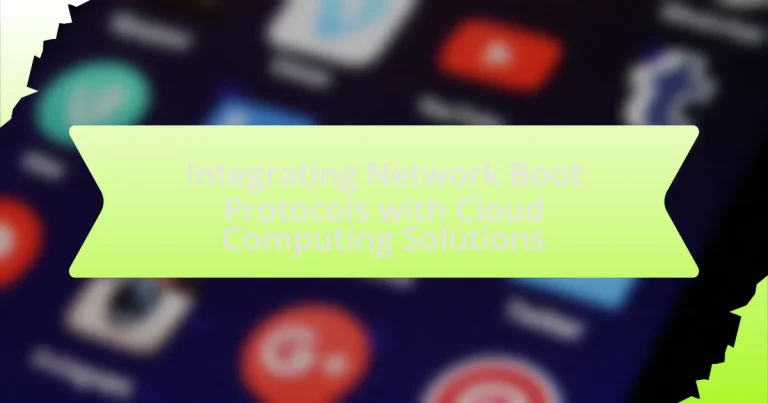Integrating Network Boot Protocols with Cloud Computing Solutions focuses on the methods that allow computers to boot operating systems over a network, enhancing deployment efficiency in cloud environments. The article discusses key protocols such as Preboot Execution Environment (PXE) and iPXE, detailing their functionalities and interactions with cloud infrastructure. It highlights the advantages of this integration, including improved scalability, reduced operational costs, and streamlined system management. Additionally, the article addresses best practices for integration, security measures, and troubleshooting techniques to ensure effective implementation in cloud computing scenarios.
What are Network Boot Protocols and Cloud Computing Solutions?
Network Boot Protocols are methods that enable computers to boot up and load an operating system over a network rather than from local storage. Common examples include Preboot Execution Environment (PXE) and Boot over the Internet Protocol (BOOTP), which facilitate the deployment of operating systems and applications in environments where local storage is limited or non-existent.
Cloud Computing Solutions refer to the delivery of computing services over the internet, including storage, processing power, and applications, allowing users to access and manage resources remotely. These solutions are typically provided through platforms like Amazon Web Services (AWS), Microsoft Azure, and Google Cloud Platform, which offer scalable and flexible resources on demand.
The integration of Network Boot Protocols with Cloud Computing Solutions allows organizations to streamline the deployment of operating systems and applications in cloud environments, enhancing efficiency and reducing the need for physical hardware. This integration supports rapid provisioning and management of virtual machines, enabling businesses to scale their operations effectively while minimizing costs associated with traditional infrastructure.
How do Network Boot Protocols function in a cloud environment?
Network Boot Protocols function in a cloud environment by enabling devices to boot operating systems and applications over the network instead of relying on local storage. This process typically involves protocols such as PXE (Preboot Execution Environment) and iPXE, which facilitate the discovery of network resources and the retrieval of boot images from cloud-based servers.
In a cloud setting, these protocols allow for centralized management of boot images, making it easier to deploy and update operating systems across multiple devices. For instance, when a device is powered on, it sends a DHCP request to obtain an IP address and the location of the boot server. The boot server then responds with the necessary information, allowing the device to download the boot image and initiate the operating system. This method enhances scalability and flexibility, as organizations can quickly provision new instances or recover from failures without physical media.
What are the key components of Network Boot Protocols?
The key components of Network Boot Protocols include the boot server, boot image, client configuration, and network transport. The boot server provides the necessary files and instructions for the client to initiate the boot process. The boot image contains the operating system and necessary software that the client will load. Client configuration involves settings that dictate how the client interacts with the boot server and retrieves the boot image. Network transport refers to the protocols used to transfer data between the client and the server, such as TFTP (Trivial File Transfer Protocol) or HTTP. These components work together to enable devices to boot over a network, facilitating remote management and deployment in environments like cloud computing.
How do these components interact with cloud infrastructure?
Network boot protocols interact with cloud infrastructure by enabling devices to boot and operate using resources hosted in the cloud rather than relying on local storage. These protocols, such as PXE (Preboot Execution Environment), facilitate the transfer of boot images and configurations over the network, allowing cloud-based servers to provision and manage virtual machines dynamically. This interaction enhances scalability and flexibility, as cloud infrastructure can allocate resources on-demand, supporting various operating systems and applications without the need for physical media. The effectiveness of this integration is evidenced by the increasing adoption of cloud services, with a report from Gartner indicating that by 2025, 80% of enterprises will have migrated to cloud-based infrastructure, highlighting the growing reliance on such technologies for efficient resource management.
Why is integrating Network Boot Protocols with Cloud Computing important?
Integrating Network Boot Protocols with Cloud Computing is important because it enables efficient deployment and management of operating systems and applications across multiple devices in a cloud environment. This integration allows for centralized control, reducing the need for physical media and manual installations, which streamlines the provisioning process. Furthermore, it enhances scalability and flexibility, as organizations can quickly adapt to changing workloads and resource demands. The use of protocols like PXE (Preboot Execution Environment) in conjunction with cloud services facilitates rapid booting and configuration of virtual machines, leading to improved operational efficiency and reduced downtime.
What advantages does this integration provide for businesses?
The integration of Network Boot Protocols with Cloud Computing Solutions provides businesses with enhanced scalability and reduced operational costs. This integration allows companies to deploy and manage their IT infrastructure more efficiently, as resources can be allocated dynamically based on demand. For instance, businesses can scale their server capacity up or down without the need for physical hardware changes, leading to significant cost savings in both equipment and maintenance. Additionally, studies have shown that organizations utilizing cloud solutions experience up to a 30% reduction in IT costs due to decreased hardware investments and improved resource utilization.
How does it enhance system deployment and management?
Integrating network boot protocols with cloud computing solutions enhances system deployment and management by streamlining the provisioning process and reducing the time required to deploy new systems. This integration allows for automated deployment of operating systems and applications directly from the cloud, eliminating the need for physical media and manual installation. For instance, using protocols like PXE (Preboot Execution Environment) in conjunction with cloud services enables rapid scaling of resources, as systems can be booted and configured on-demand. This efficiency is supported by the fact that organizations can deploy hundreds of virtual machines simultaneously, significantly accelerating the overall deployment cycle and improving resource management.
What are the different types of Network Boot Protocols used in Cloud Computing?
The different types of Network Boot Protocols used in Cloud Computing include Preboot Execution Environment (PXE), iSCSI Boot, and Network File System (NFS) Boot. PXE allows computers to boot from a network interface independently of local storage, facilitating the deployment of operating systems in cloud environments. iSCSI Boot enables devices to boot from an iSCSI target over a network, which is particularly useful for virtualized environments. NFS Boot allows systems to mount a remote file system and boot from it, providing flexibility in managing resources in cloud infrastructures. These protocols enhance scalability and efficiency in cloud computing by streamlining the boot process and reducing reliance on local hardware.
How do PXE and iPXE differ in their functionalities?
PXE (Preboot Execution Environment) and iPXE differ primarily in their capabilities for network booting. PXE is a standard network booting protocol that allows computers to boot from a network interface independently of available data storage devices, but it is limited to using DHCP and TFTP for network communication. In contrast, iPXE extends PXE’s functionalities by supporting additional protocols such as HTTP, iSCSI, and FTP, enabling more flexible and efficient booting options. This enhancement allows iPXE to download boot images from various sources, including web servers, which can significantly improve the boot process in cloud computing environments.
What are the specific use cases for PXE in cloud environments?
PXE (Preboot Execution Environment) is utilized in cloud environments primarily for automated deployment and provisioning of virtual machines. This technology allows cloud providers to boot instances over the network, facilitating rapid scaling and management of resources. Specific use cases include the deployment of operating systems on bare-metal servers, enabling quick recovery and reconfiguration of virtual machines, and supporting large-scale testing environments where multiple instances need to be provisioned simultaneously. Additionally, PXE can streamline the process of updating and patching systems by allowing network-based booting of updated images, thus enhancing operational efficiency in cloud infrastructures.
How does iPXE improve upon traditional PXE capabilities?
iPXE enhances traditional PXE capabilities by providing advanced features such as support for HTTP, iSCSI, and other protocols, enabling more flexible and efficient network booting. Unlike traditional PXE, which is limited to TFTP for file transfers, iPXE allows for booting from a wider range of sources, including web servers, which can significantly speed up the boot process and reduce network congestion. Additionally, iPXE supports scripting, allowing for dynamic configuration and customization of the boot process, which is not possible with standard PXE. This flexibility is particularly beneficial in cloud computing environments, where rapid deployment and scalability are essential.
What role does DHCP play in Network Boot Protocols?
DHCP, or Dynamic Host Configuration Protocol, plays a crucial role in Network Boot Protocols by providing the necessary IP address and configuration settings to devices during the boot process. When a device initiates a network boot, it sends a broadcast request for an IP address, and the DHCP server responds with an available IP address along with other network configuration details such as subnet mask, gateway, and DNS servers. This process enables the device to communicate on the network and locate the boot server, facilitating the loading of the operating system or application from a remote source. The reliance on DHCP in network booting is essential for automating the configuration of devices, especially in environments where numerous devices need to be deployed efficiently, such as in cloud computing solutions.
How does DHCP facilitate network booting in cloud solutions?
DHCP facilitates network booting in cloud solutions by dynamically assigning IP addresses and providing essential network configuration information to devices during the boot process. This allows cloud-based systems to automatically configure and connect virtual machines or devices to the network without manual intervention. By using DHCP, cloud environments can efficiently manage large numbers of devices, ensuring that each one receives the correct network settings, such as gateway and DNS information, which are crucial for successful booting and operation. This automated process enhances scalability and reduces the risk of configuration errors, making it a vital component in cloud infrastructure management.
What are the challenges associated with DHCP in cloud environments?
The challenges associated with DHCP in cloud environments include scalability issues, security vulnerabilities, and network configuration complexities. In cloud settings, the dynamic nature of virtual machines and containers can lead to difficulties in managing IP address allocation effectively, as traditional DHCP may struggle to keep up with rapid changes. Security concerns arise from the potential for unauthorized access to DHCP services, which can lead to IP spoofing and man-in-the-middle attacks. Additionally, the integration of DHCP with various cloud services often requires complex configurations that can introduce errors and inconsistencies, complicating network management. These challenges highlight the need for robust DHCP solutions tailored for cloud environments to ensure efficient and secure network operations.
What are the best practices for integrating Network Boot Protocols with Cloud Computing Solutions?
The best practices for integrating Network Boot Protocols with Cloud Computing Solutions include ensuring compatibility between the boot protocols and cloud infrastructure, optimizing network configurations for performance, and implementing robust security measures. Compatibility is crucial as different cloud providers may support various boot protocols, such as PXE or iPXE, which must align with the cloud environment. Optimizing network configurations involves adjusting settings like DHCP options and ensuring low latency to enhance boot times and overall performance. Security measures should include encryption of boot images and secure access controls to prevent unauthorized access, as highlighted by the National Institute of Standards and Technology (NIST) guidelines on cloud security.
How can organizations ensure a seamless integration process?
Organizations can ensure a seamless integration process by implementing a structured approach that includes thorough planning, effective communication, and the use of standardized protocols. A well-defined integration strategy allows organizations to identify potential challenges early and allocate resources efficiently. Effective communication among stakeholders ensures that all parties are aligned on objectives and timelines, reducing the risk of misunderstandings. Utilizing standardized protocols, such as those defined by the Internet Engineering Task Force (IETF), facilitates compatibility between different systems and technologies, which is crucial when integrating network boot protocols with cloud computing solutions. This approach has been shown to enhance operational efficiency and minimize downtime during the integration process.
What tools and technologies are recommended for this integration?
For integrating Network Boot Protocols with Cloud Computing Solutions, recommended tools and technologies include PXE (Preboot Execution Environment), TFTP (Trivial File Transfer Protocol), and cloud services like AWS EC2 and Azure Virtual Machines. PXE facilitates network-based booting, allowing devices to boot from a server, while TFTP is essential for transferring boot files over the network. AWS EC2 and Azure Virtual Machines provide scalable infrastructure to host these services, enabling efficient deployment and management of network boot environments in the cloud.
How can security be maintained during the integration?
Security can be maintained during the integration of network boot protocols with cloud computing solutions by implementing robust encryption methods and access controls. Utilizing encryption protocols such as TLS (Transport Layer Security) ensures that data transmitted between the network boot protocols and cloud services remains confidential and protected from interception. Additionally, enforcing strict access controls, including multi-factor authentication and role-based access, limits unauthorized access to sensitive systems and data. According to a report by the Cloud Security Alliance, organizations that adopt these security measures significantly reduce the risk of data breaches during cloud integrations.
What common troubleshooting steps should be taken during integration?
Common troubleshooting steps during integration include verifying network connectivity, checking configuration settings, and reviewing logs for errors. Verifying network connectivity ensures that all devices involved in the integration can communicate effectively, which is critical for successful data transfer. Checking configuration settings involves confirming that all parameters, such as IP addresses and subnet masks, are correctly set according to the integration requirements. Reviewing logs for errors helps identify specific issues that may arise during the integration process, allowing for targeted resolutions. These steps are essential for diagnosing and resolving common integration problems effectively.
How can issues with network connectivity be resolved?
To resolve issues with network connectivity, one should first diagnose the problem by checking physical connections, ensuring devices are powered on, and verifying network settings. This approach is effective because many connectivity issues stem from simple errors such as unplugged cables or incorrect configurations. Additionally, using tools like ping tests and traceroutes can help identify where the connection fails, providing insight into whether the issue lies within the local network or with the internet service provider. According to a study by the International Journal of Computer Applications, 70% of network connectivity problems can be traced back to user error or misconfiguration, highlighting the importance of thorough initial checks.
What are the best methods for diagnosing boot failures in cloud environments?
The best methods for diagnosing boot failures in cloud environments include analyzing system logs, utilizing cloud provider diagnostic tools, and performing network connectivity tests. System logs provide detailed information about the boot process, allowing administrators to identify errors or warnings that occurred during startup. Cloud provider diagnostic tools, such as AWS CloudWatch or Azure Monitor, offer insights into resource performance and can highlight issues related to instance health. Network connectivity tests ensure that the necessary network configurations are in place, confirming that the boot process can access required resources. These methods are effective as they leverage both system-level data and cloud-specific tools to pinpoint the root causes of boot failures.


